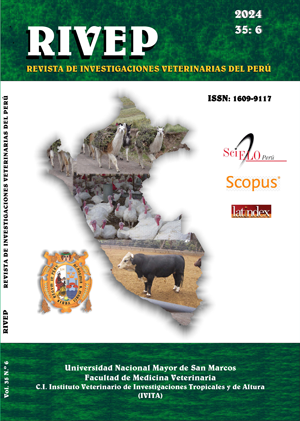Determination of the average diameter and percentage of medullation of representative fibres of alpaca fleeces
DOI:
https://doi.org/10.15381/rivep.v35i6.27805Keywords:
South American camelids, mid-rib area, fineness, subsampleAbstract
The evaluation of the mean fibre diameter (MFD) and the incidence of representative medullation of alpaca fleeces in 10 g samples of fibres from the mid-rib area is usually carried out to identify fine animals in genetic improvement programmes. Subsamples are usually taken from each sample to determine the MFD with some type of measuring instruments; however, due to the great variability of the diameter between staples, between fibres and along the same fibre, there is no consensus on the number of subsamples to use to achieve a representative result for the sample. In the present study, results from a range of subsamples were evaluated against the result of the total subsamples for MFD measurements and for measurements of the following additional variables of interest in alpaca fleeces: total percentage of medullated fibres (PMedT), percentage of fibres with fragmented medulation (PMedFrag), with discontinuous medulation (PMedDisc), with continuous medulation (PMedCont), strongly medullated (PFuertMed), mean diameter of medullated fibres (MDFMed), mean diameter of fibres with fragmented modulation (MDFFrag), mean diameter of fibres with discontinuous medulation (MDFDisc), mean diameter of fibres with continuous medulation (MDFCont) and mean diameter of strongly medullated fibres (MDFFuertMed). Samples of 10 g were taken from the mid-rib area of 62 alpacas. From a group of 30 samples, 17 subsamples were taken, allowing 510 evaluations; and from the second group of 32 samples, 9 subsamples were extracted, allowing 288 evaluations. The subsamples were analysed with the Fiber EC and Fiber Med instruments and the data obtained were statistically analysed using Spearman and Pearson correlations, paired mean tests and variance components estimated with a linear model that includes sample and subsample nested in sample. It is concluded that to achieve a correlation greater than 0.990, at least three to five subsamples are required in the evaluation of MFD, two or three subsamples in the evaluation of PMedT, PMedFrag, PMedDisc and PMedCont with their respective MFD and at least five subsamples in the evaluation of PFuertMed and its MFD.
Downloads
Downloads
Published
Issue
Section
License
Copyright (c) 2024 Edgar Quispe Peña, Jorge Aliaga Gutiérrez, Jorge Gamarra Bojorquez, Joaquín Mueller, Diego Sacchero, Freddy Marrero Saucedo, Max David Quispe Bonilla

This work is licensed under a Creative Commons Attribution 4.0 International License.
AUTHORS RETAIN THEIR RIGHTS:
a. Authors retain their trade mark rights and patent, and also on any process or procedure described in the article.
b. Authors retain their right to share, copy, distribute, perform and publicly communicate their article (eg, to place their article in an institutional repository or publish it in a book), with an acknowledgment of its initial publication in the Revista de Investigaciones Veterinarias del Perú (RIVEP).
c. Authors retain theirs right to make a subsequent publication of their work, to use the article or any part thereof (eg a compilation of his papers, lecture notes, thesis, or a book), always indicating the source of publication (the originator of the work, journal, volume, number and date).



